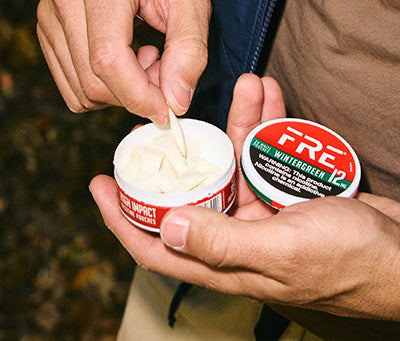Can you take nicotine pouches on a plane? Yes, TSA permits them in both carry-on and checked luggage in 2025. Screening is simple, but travelers still need to know the difference between TSA rules, airline discretion, and destination laws.
According to TSA data, U.S. airports screened over 900 million passengers in 2024, and personal items like nicotine pouches are increasingly common at checkpoints. With so many travelers, understanding what’s allowed saves time and avoids unnecessary delays.
Here’s what we’ll tackle in this guide:
-
TSA’s official stance on nicotine pouches in 2025
-
Carry-on vs checked bag considerations
-
How airline policies affect in-flight use
-
Packing tips that prevent security confusion
-
What to know about international and customs rules
TSA’s Official Policy on Nicotine Pouches
So what exactly does TSA say about nicotine pouches? The agency lists tobacco items as permitted in both carry-on and checked luggage. Unlike vapes or e-cigarettes, pouches aren’t electronic and don’t carry batteries. That’s a big difference because battery-powered items must always stay in the cabin. With pouches, you have flexibility, and it comes down to how you prefer to travel.
Carry-On vs Checked: What’s Allowed
Both options are permitted, but each has a practical side.
-
Carry-On Bags
-
Quick access if you’re on a long flight
-
Lower chance of getting lost or delayed
-
TSA can see and confirm the packaging more easily
-
Checked Luggage
-
Keeps your personal bag lighter
-
Reduces questions at the security line
-
Useful if you’re traveling with multiple tins
Any Limits or Special Rules?
TSA doesn’t set a hard number for how many pouches you can bring. Instead, they apply a “reasonable amount for personal use” guideline. That means a couple of tins of Wintergreen nicotine pouches is fine, but carrying dozens of cans might raise eyebrows. Officers have discretion, and if your bag looks like a bulk shipment, you may get pulled aside.
Age restrictions also matter. Federal law says nicotine products are for travelers 21 and older, and TSA follows that rule. Don’t hand over a pouch to someone younger in line, because it can bring unwanted attention.
If you’re moving products for business rather than personal use, labeling matters. That’s where the FRE trade inquiries page comes in. Retail shipments have a different process, and clear labeling keeps them separate from what you pack for yourself.
Travelers often ask how many tins fit easily in a bag. For us, a collection of nicotine pouch products usually slips into one corner of a backpack. They’re light, compact, and don’t need any special storage. Compared to liquids that must follow the 3-1-1 rule, it’s refreshingly simple.
Airline Policies & In-Flight Use
TSA may clear you at the security checkpoint, but once you step onto the plane, the rules shift to your airline. That’s where things can get confusing. Some carriers treat pouches as simple personal items, while others group them with smokeless tobacco and apply stricter policies. In practice, most U.S. airlines don’t object to passengers carrying tins of Lush nicotine pouches or Sweet pouch varieties. Where things get tricky is when passengers actually use them in the cabin.
Cabin crews have the final say. A flight attendant can tell you to stop if they believe the product violates company policy. That doesn’t happen often, but it does occur. International airlines may be even stricter, especially when their home country regulates nicotine differently. On some routes you’ll breeze through with your Original nicotine pouches tin, while on others you might be asked to stow it away until landing.
How Airlines Handle Nicotine Pouches
Here are a few general patterns we’ve seen when traveling with FRE tins:
-
Domestic U.S. Airlines
-
Most allow pouches to be carried and used since they don’t emit smoke
-
Crew may remind you to dispose of used pouches in the trash, not the seat pockets
-
Having your product labeled and sealed avoids questions
-
International Carriers
-
More likely to classify pouches as smokeless tobacco
-
May prohibit use during flight, even if carry-on is fine
-
Enforcement can vary by region, with stricter rules in Europe and Asia
-
Budget Airlines
-
Policies are often less clear on their websites
-
Crew discretion plays a bigger role
-
Packing light, clearly marked tins usually avoid hassle
What If Airlines Prohibit “Smokeless Tobacco”?
This is where the wording matters. Some carriers’ rulebooks list “smokeless tobacco” under restricted items. Technically, nicotine pouches are tobacco-free, but you may still be asked to follow those restrictions.
The difference can feel frustrating, but arguing mid-flight never ends well. It’s better to pack backup tins in checked luggage and keep a smaller tin from the FRE in your personal bag for reference.
Policies change, too. An airline that allowed them last year might update its rulebook this year. That’s why keeping an eye on both TSA guidance and airline-specific policies is smart.
Tips for Packing Nicotine Pouches for Travel
Packing nicotine pouches for a trip sounds straightforward, throw them in a bag and go. But if you’ve ever had an item pulled at security or crushed in your luggage, you know the small details matter. Instead of repeating the usual “keep them sealed” advice, here are practical strategies you can use to pack smarter and avoid headaches.
-
Use a Travel Pill Organizer for Short Trips: Pill cases with daily slots are perfect for separating small amounts of pouches. TSA agents can see everything clearly, and you don’t have to dig through multiple tins. Just keep at least one original tin with you for labeling, in case anyone asks.
-
Slip Tins Into Hard Sunglasses Cases: A sunglasses case is crush-proof and fits nicely in any carry-on pocket. It keeps tins from popping open mid-flight and doubles as an extra layer of discretion. This is especially useful for metal tins that tend to rattle around.
-
Pack Desiccant Packets to Protect Flavor Integrity: Air pressure and humidity changes in flights can dry products out. Tossing a small silica gel packet inside your pouch container can help keep them stable during long-haul trips. It’s subtle, but it preserves freshness when you’re traveling across climates.
-
Split Tins Between Multiple Bags: We know TSA allows pouches, but lost luggage happens. Keep one tin in your carry-on, another in a checked bag, and maybe one in a personal item like a laptop sleeve. If any bag is delayed or inspected longer, you’ll still have a backup handy.
-
Wrap Tins in Socks or Scarves for Cushioning: This is about protection. Socks or scarves keep tins from rattling around and prevent denting, especially if you’re tossing them into a packed suitcase. It’s a low-effort way to keep them looking intact on arrival.
-
Carry Resealable Snack Bags for Quick Swaps: Instead of juggling tins in tight airplane seats, keep a few pouches in a resealable snack bag. It’s quicker to access during a flight and less noticeable when you’re on the move. You can refill it at layovers without digging into your main stash.
-
Mark Tins With Travel Stickers: A tiny sticker or mark on your tins helps you quickly distinguish “travel stock” from the rest. This matters if you’re traveling with multiple flavors or strengths, you won’t have to open every tin mid-flight just to find the one you want.
-
Use a Tech Accessory Case as Storage: Accessory cases made for earbuds or charging cables are padded, zippered, and compact. They’re surprisingly good at keeping tins organized. Plus, they’re less likely to attract attention at screening than loose tins rolling around in a bag.
-
Rotate Stock Before You Leave: Don’t take all your oldest tins on the road. Rotate your stash so you’re not stuck with products that might dry out mid-trip. Fresh tins make long flights more manageable, and you’ll thank yourself during a layover when options matter.
-
Keep Travel-Sized Hand Sanitizer Nearby: Not for TSA compliance, but for after you handle tins in public areas. Security bins aren’t the cleanest surfaces, and having sanitizer handy makes your travel routine smoother. It’s a small detail, but it keeps your gear cleaner throughout the journey.
How Many Is Too Many?
There’s no strict limit, but TSA officers work off the idea of personal use. A couple of cans won’t raise eyebrows. A whole suitcase filled with tins might. If you need larger quantities, especially for business, the FRE trade inquiries page is the right path because that falls under distribution, not personal travel.
Carry-On vs Checked: A Comparison
It often helps to split your supply. Keeping one or two tins of nicotine pouches in your personal bag is convenient, while extras can ride in checked luggage. Here’s a quick comparison:
|
Packing Choice |
Advantages |
Considerations |
|
Carry-On |
Access during layovers and long flights |
Bag is screened more closely; keep tins sealed |
|
Checked Bag |
Keeps your backpack lighter, avoids questions at security |
Risk of luggage delay; better for larger supplies |
Handling Use During the Flight & Discretion
You’ve made it past TSA and boarded the plane, but the question many travelers have is what happens once the seatbelt light comes on. Airlines don’t have a universal rule on pouch use. Some don’t mention it at all, while others lump them with smokeless tobacco and expect passengers to avoid using them. That means the real decision often falls to the cabin crew.
If a flight attendant sees you with a tin, they may not say anything. In other cases, they might remind you to wait until landing. We’ve noticed this varies by route and carrier. On domestic flights, the crew is usually focused on bigger issues, but international carriers can be stricter.
A few practical steps make the difference:
-
Always Carry a “Reference Tin”: Even if you transfer pouches into smaller bags for convenience, keep one official tin in your pocket. If crew or customs ask questions, showing them the labeled packaging avoids confusion and shortens the conversation.
-
Bring a Mini Trash Bag for Discreet Disposal: Seatback pockets aren’t the place for used pouches. Carry a small, opaque mini bag that fits in your pocket or backpack. Toss used pouches in there until the trash cart comes by. It shows consideration and avoids awkward cleanup.
-
Time Your Usage Around Meal Service: Crews are busiest during boarding, takeoff, and meal service. Wait until after trays are cleared to use a pouch. This way, you’re less likely to draw unwanted attention when the crew is moving up and down the aisle.
-
Keep Pouches in Your Jacket Pocket for Easy Access: Instead of fumbling with carry-ons in cramped rows, slip a tin into your jacket pocket. It makes access seamless, especially on long-haul flights where climbing over seatmates isn’t practical.
-
Learn Airline Terminology Before Boarding: Some carriers officially classify nicotine pouches as “smokeless tobacco.” Knowing their phrasing helps you respond quickly if crew ask. Saying “yes, these are smokeless pouches” often aligns with their manual and avoids confusion.
-
Keep Quantities Consistent With Trip Length: Customs officers often ask, “How long are you staying?” If you’re traveling for a weekend but carrying ten tins, it may look suspicious. Match your supply to your trip length, and you’ll face fewer questions at borders.
-
Carry a Translation Card for Non-English Customs: If you’re traveling to a country where English isn’t widely used, write a short translation card explaining what nicotine pouches are. Handing that to customs makes inspections faster and shows transparency.
-
Separate Business From Personal Use: If you’re traveling for retail or distribution reasons, keep personal tins apart from bulk stock. Customs want to see a clear line between the two. Using a dedicated pouch for your personal stash shows that you’re not trying to sneak in commercial quantities.
-
Stay Polite Even When Confused: Sometimes rules don’t make sense. You might get conflicting answers from different officers. Staying calm and polite, even if you’re frustrated, usually leads to a better outcome. We’ve seen travelers lose products simply because they argued.
What to Do If You’re Traveling to / Through Places with Different Laws
TSA clears nicotine pouches in the U.S., but that approval doesn’t follow you everywhere. Once you land abroad, local laws can change the rules. Some European airports treat pouches like smokeless tobacco and enforce limits. In Australia, bringing even one tin can lead to fines. A trip that felt easy at the departure gate can suddenly feel complicated at customs. To stay ahead, here are strategies that go beyond the obvious.
1. Research Customs Rules Weeks in Advance
Don’t wait until the night before your flight. Many countries publish nicotine restrictions online, and rules can change with little notice. Checking early gives you time to adjust how much you pack. If you know why nicotine pouches are more convenient for travel, you know the small details matter when it comes to planning.
2. Match Supply to Your Trip Length
Agents often compare your stash to your itinerary. If you’re on a four-day trip with ten tins, it looks suspicious. A couple of cans of nicotine pouches for a short getaway usually passes without questions. Keeping the quantity realistic avoids red flags.
3. Use a Travel Checklist Before Departure
It’s easy to forget small steps when you’re rushing to pack. Creating a simple checklist helps: confirm customs laws, double-check that tins are sealed, and set aside a backup stash in checked luggage.
4. Protect Pouches From Climate Shifts
Crossing time zones and climates can affect freshness. Humidity and heat in certain regions may dry out tins faster. Small tricks, like using airtight containers or silica packets, make a difference. For longer trips, learn how to store FRE nicotine pouches for maximum freshness.
5. Always Double-Check During Layovers
Connecting flights can complicate things. Even if your destination allows pouches, a layover in a restrictive country might cause issues. It’s worth treating layovers like mini-destinations and checking their rules too.
Keep Best Practices for Traveling with Nicotine Pouches in Mind
By now, you’ve seen how simple TSA’s stance is compared to the patchwork of airline and international policies. The agency allows pouches through security in either bag, but airlines and customs officers may apply their own interpretations. That’s why the best strategy is a mix of preparation and common sense.
In the end, it’s less about memorizing every rule and more about knowing the basics. TSA says yes, airlines have the final say in the cabin, and customs may want proof that your pouches are for personal use. Keeping these points in mind makes travel smoother. If you’re not sure what to pack, starting with a couple of tins from FRE and spreading them across your bags is a safe bet.





